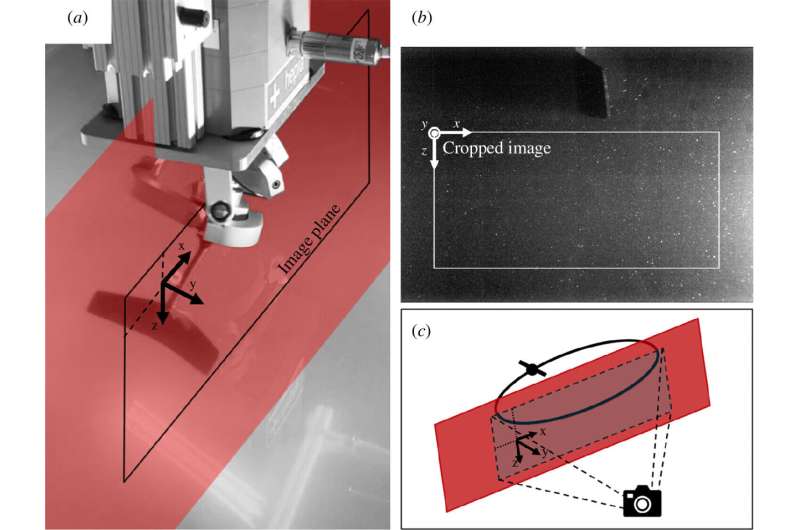Fish fins and insect wings are amazing pieces of natural engineering capable of efficiently moving their owners through water or air. People creating machines to swim or fly have long looked to animals as their models, designing airplanes with wings and boats with fin-shaped rudders. Over the past decades, researchers at Caltech and elsewhere have been exploring bioinspired engineering to see if other natural forms of motion might inform mechanical engineering.
“Bio-inspired compensatory strategies for damage to flapping robotic propulsors” was published in the July 3 issue of the Journal of the Royal Society Interface.
Many animals use flapping as a means of propulsion, and robots equipped with flappers can also propel themselves efficiently. But the flappers of the animal kingdom—in this case fish and insects—have another trick up their sleeve. Even with damaged wings or fins, these animals can adapt the mechanics of their motions to compensate. Some species of fish can survive with as much as 76 percent of their fins damaged and still be able to swim.
Could a robotic flapper achieve the same feat? This is the question that inspired a study in the lab of Mory Gharib (Ph.D. ’83), the Hans W. Liepmann Professor of Aeronautics and Medical Engineering, the director and Booth-Kresa Leadership Chair of the Center for Autonomous Systems and Technologies (CAST), and director of the Graduate Aerospace Laboratories at Caltech.
Gharib, together with Meredith Hooper, an aerospace graduate student, and Isabel Scherl, a postdoctoral scholar research associate in mechanical and civil engineering, analyzed a flapping robot’s motions in a tank of oil, which allows for more accurate measurements than water due to its signal-to-noise ratio. They then amputated a portion of the robot’s flapper.
Machine learning for propulsion adaptation
Without intervention, the robot would still be flapping futilely in the tank, having lost its ability to swim. But in addition to bioinspired propulsion, the researchers also gave the robot bioinspired adaptation. Following an injury, fish and insects attempt to propel themselves in new ways, experimenting until they find the stroke mechanics that can return them to full activity.
Mimicking this, the robot was programmed to run repeated trials of various stroke mechanics, which were then evaluated through machine learning. Eventually, the robot, like an injured fish or insect, achieved a successful alternative form of propulsion with its damaged flapper even when 50 percent of it was removed.
“The robot tries swimming in 10 different ways,” Hooper explains. “The forces while it is swimming in the oil tank are measured so that we can compare both the force production and its efficiency. The machine learning algorithm selects the top candidate trajectories based on how well they produced our desired force. The algorithm then comes up with another set of 10 trajectories inspired by the previous set.
“This learning process repeats—evaluation, modification, and creation—until the top candidates are all more or less the same, having learned the most efficient swimming motion for a given force production.”

Propulsion adaptation in practice
An autonomous robot is only autonomous until it is not, owing to some type of damage or malfunction. By endowing robotic mechanisms with the ability to adapt to changed capabilities through machine learning, the scope of their autonomy is increased.
As Hooper says, “Autonomous underwater vehicles (AUVs) that provide crucial information about how our oceans work—what exists in the deep sea, how human activities are disrupting ocean dynamics—are very expensive to build and deploy. If an AUV’s propulsion system fails in an inaccessible area without this means of adaptation, it essentially becomes ocean trash. Our finding should increase the probability that an AUV could successfully complete its mission and be recovered.”
“Adaptability through machine learning may also improve the function of micro air vehicles (MAVs) which can navigate small gaps in complex terrain during emergency-response scenarios such as searching for trapped individuals in the aftermath of an earthquake. This type of terrain makes it more likely that the MAV will be damaged during its search. Our finding could make MAVs more robust for deployment in challenging environments where damage could be common,” Hooper says.
Although both the experimental robot and living animals can modify their stroke mechanics to adapt to damage, they do not make the same modifications. Theoretically, in all cases, the flappers (or fins or wings) should change both amplitude and frequency to achieve optimal propulsion after damage. But most studies of fish with fin damage show that the fish increase the amplitude but not necessarily the frequency of their strokes to compensate, while the robot modified both.
“This is most likely due to the effect of evolutionary pressures on fish and insects that aren’t relevant to a robotic use case,” Hooper explains. “How flapping robots best adjust to damage does not necessarily mimic nature.”
More information:
M. L. Hooper et al, Bio-inspired compensatory strategies for damage to flapping robotic propulsors, Journal of The Royal Society Interface (2024). DOI: 10.1098/rsif.2024.0141
Citation:
Robots, like animals, can adapt after injuries (2024, July 31)
retrieved 31 July 2024
from https://techxplore.com/news/2024-07-robots-animals-injuries.html
This document is subject to copyright. Apart from any fair dealing for the purpose of private study or research, no
part may be reproduced without the written permission. The content is provided for information purposes only.





